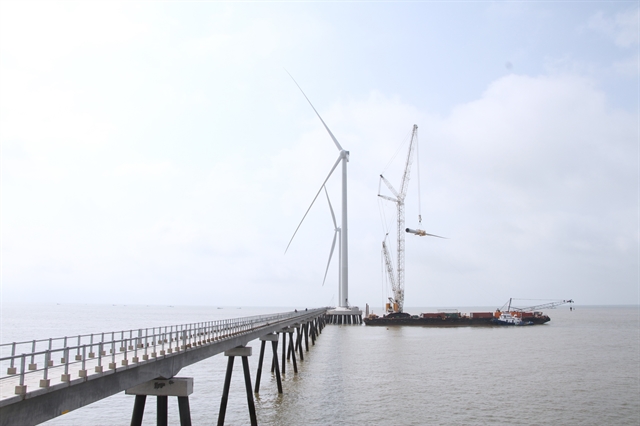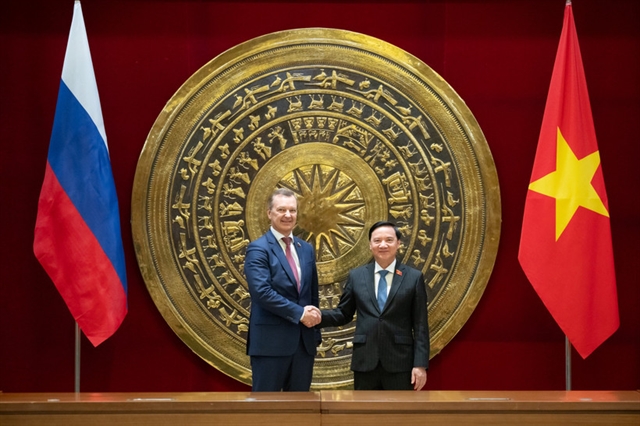 Opinion
Opinion


|
| Installation of wind turbine blades at a wind power project in the southern province of Bạc Liêu. — VNA/VNS Photo Chanh Đa |
Energy expert Phan Công Tiên spoke to Business Forum Magazine about bidding for renewable energy projects, particularly bidding procedures and advantages.
Why is the bidding mechanism considered feasible compared to other mechanisms?
As we all know, Feed-in tariffs (FIT) are fixed electricity prices that are paid to renewable energy (RE) producers for each unit of energy produced and injected into the electricity grid.
FIT prices can only be developed at a specific stage with a limited amount of participating capacity to avoid a great influence on the fluctuation of the retail electricity output price. In the long term, to develop renewable energy, it is necessary to have a mechanism to balance solutions and methods to develop methodically and sustainably following market’s moves. The bidding mechanism is one of high feasibility ones that countries around the world are successfully applying.
Currently, for other economic sectors, we are also applying bidding mechanism and seeing very clearly its benefits from fair price competition, meeting standards and regulations, bringing fairness and benefits to buyers. However, in Việt Nam, the application of the bidding mechanism for renewable energy is still quite new and there is a lack of legal documents in this field.
Through studying international experience, what do you think about the implementation of bidding to develop renewable energy sources?
In the field of renewable energy, from 2005 to 2017, 29 countries started bidding. In 2018, at least 48 countries organised bidding. So far, 80 countries have conducted bidding for renewable energy projects. According to a report by the United States Agency for International Development (USAID), some projects developed through competitive bidding have a record low price, for example, in 2017, solar power projects in Mexico got the price of 1.9 cents/kWh, in Chile 2.1 cents/kWh, in Saudi Arabia 2.3 cents/kWh and in Abu Dhabi/UAE 2.4 cents/kWh.
Similarly, there are also record low prices for some onshore wind projects in Mexico at 1.8 cents/kWh, in Morocco at 2.5 cents/kWh and in Brazil at 3 cents/kWh. In Zambia and Senegal, solar power projects won the biddings at a price of 6 cents/kWh in 2016 and 4.7 cents/kWh in 2017. In Kazakhstan in 2018 the onshore wind price was 5.3 cents/kWh . In Afghanistan, solar power projects got the price at 7.3 cents/kWh in the 2016 tender.
The above-mentioned record low electricity price results through bidding may not reflect the general nature of the market-based renewable energy price through bidding because it depends on many factors and situations. However, it can be seen that the bidding mechanism creates a real competitive opportunity, helping electricity buyers directly benefit from the most competitive electricity purchase prices.
In addition to achieving competitive price results, are there any other benefits of holding tenders for renewable energy development?
When bidding, the organisation of the implementation is public, transparent and widely informed, from which stakeholders such as investors, power transmission units, power distribution and other related agencies will have a basis and time to coordinate more smoothly in project preparation, transmission line preparation, distribution grid. So, when the power plant is completed, investors can avoid situations that cause losses for them, for example, capacity cuts.
On the other hand, through bidding, the Government sets criteria in the bidding documents, thereby better orienting and balancing the amount of renewable energy capacity developed by the region. In addition, with this tool, the Government orients a reasonable percentage of localisation, which is a very good tool to create opportunities to develop domestic supply chains, contributing to promoting other support industries in the supply chain of renewable energy materials and equipment.
For example, according to the report of the International Renewable Energy Agency (IRENA), in China, the requirement on local content for onshore wind power bidding was set at 50 per cent in 2003 and increased to 70 per cent in 2005. The bidding mechanism played an important role in developing the domestic wind energy industry. Through this way, many international suppliers of renewable energy equipment have to invest or cooperate with domestic enterprises to produce wind power equipment in the country, and in fact many Chinese companies have grown and reached world.
In addition, renewable energy bidding creates an open and fair "playground” for all investors, both private and state-owned enterprises can participate equally. The bidding will sort and identify investors with strong capacity who will accompany in the long term to meet the requirements of sustainable development, ensuring the national energy security goals.

|
| Energy expert Phan Công Tiên.— Photo diendandoanhnghiep.vn |
How can a bidding be opened for a renewable energy project?
There are many different bidding methods depending on the characteristics of each country to make appropriate decisions. For example, giving the size of the power source capacity that needs to be added to the system with a few tens to several hundred MW for each bidding phase, or bidding according to the size of the power generation output with a few dozen to several hundred MWh according to the timelines or according to the size of the financial package with the total amount obtained, etc.
In addition, the bidding is also classified by technology characteristics such as solar power (solar farm), onshore wind power, offshore wind power, small hydroelectricity, biomass power or mixed technology scale i.e. combining many types of electricity, different technologies for a bidding package. The bidding is also divided into the form of bidding that has not yet determined the exact project location and the form of determining the specific project location.
It means that to request a tender to provide a certain load area for a certain size of power source, the investor will choose his or her own project location in the load area to bid, or the Government designates a specific project location, investors bid competitively on this specific project location.
In addition, there are also types of closed-profile bidding, i.e. fixed bid prices, and open bidding types with many stages to negotiate prices and volumes. For example, in the Philippines in early 2022, according to the report, the Philippine Department of Energy announced a tender for a capacity of 2000Mw of renewable energy sources added to the national electricity system by the bidding method on a case-by-case technology, and supplement for each specific load area, including in Luzon area with 80Mw small hydroelectricity, 60Mw biomass power, 900Mw farm solar power, 360Mw onshore wind power.; Visayas area with 120Mw biomass power, 260Mw solar power, 20Mw wind power, and Mindanao area with 50mw small hydro, 50mw biomass and 100Mw solar power.
How is the bidding process for renewable energy projects in other countries?
Based on the National Power Plan and regional load demand, the Governments of the countries annually set the renewable energy target to have a bidding plan for renewable energy projects to meet the new electricity capacity market.
The agency in charge of bidding is usually a specialised agency under a specialised ministry, commonly the Ministry of Energy/Ministry of Industry and Trade.
Other relevant government agencies, regulatory electricity system operators (or Electricity Market), transmission and distribution management units, etc also participate the bidding group. However, the most important thing is to identify the project list and related legal system to implement the bidding.
After determining the scale of renewable energy to be added to the system, the bidding process is almost the same as bidding for other kinds of projects that we are currently implementing. — VNS




